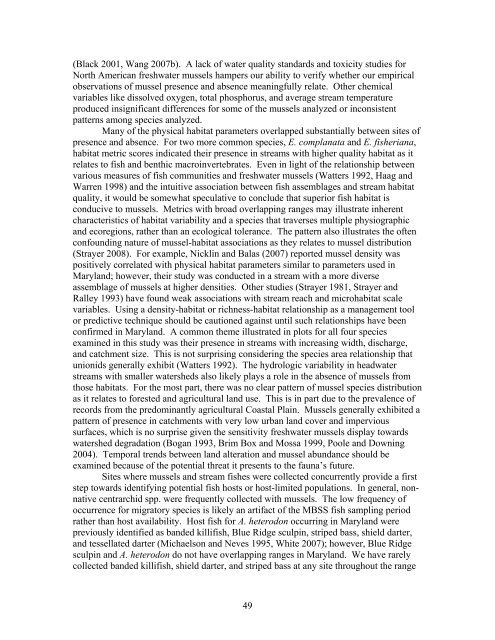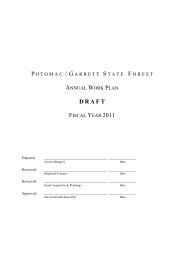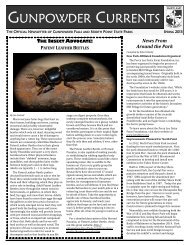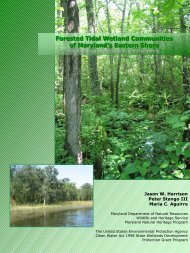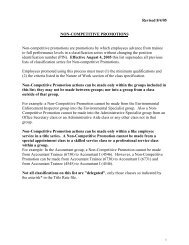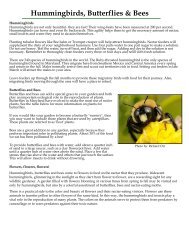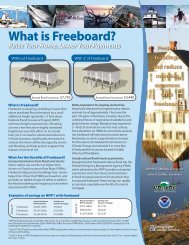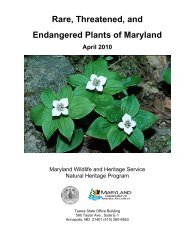Freshwater mussel records collected by the Maryland Department of ...
Freshwater mussel records collected by the Maryland Department of ...
Freshwater mussel records collected by the Maryland Department of ...
You also want an ePaper? Increase the reach of your titles
YUMPU automatically turns print PDFs into web optimized ePapers that Google loves.
(Black 2001, Wang 2007b). A lack <strong>of</strong> water quality standards and toxicity studies for<br />
North American freshwater <strong>mussel</strong>s hampers our ability to verify whe<strong>the</strong>r our empirical<br />
observations <strong>of</strong> <strong>mussel</strong> presence and absence meaningfully relate. O<strong>the</strong>r chemical<br />
variables like dissolved oxygen, total phosphorus, and average stream temperature<br />
produced insignificant differences for some <strong>of</strong> <strong>the</strong> <strong>mussel</strong>s analyzed or inconsistent<br />
patterns among species analyzed.<br />
Many <strong>of</strong> <strong>the</strong> physical habitat parameters overlapped substantially between sites <strong>of</strong><br />
presence and absence. For two more common species, E. complanata and E. fisheriana,<br />
habitat metric scores indicated <strong>the</strong>ir presence in streams with higher quality habitat as it<br />
relates to fish and benthic macroinvertebrates. Even in light <strong>of</strong> <strong>the</strong> relationship between<br />
various measures <strong>of</strong> fish communities and freshwater <strong>mussel</strong>s (Watters 1992, Haag and<br />
Warren 1998) and <strong>the</strong> intuitive association between fish assemblages and stream habitat<br />
quality, it would be somewhat speculative to conclude that superior fish habitat is<br />
conducive to <strong>mussel</strong>s. Metrics with broad overlapping ranges may illustrate inherent<br />
characteristics <strong>of</strong> habitat variability and a species that traverses multiple physiographic<br />
and ecoregions, ra<strong>the</strong>r than an ecological tolerance. The pattern also illustrates <strong>the</strong> <strong>of</strong>ten<br />
confounding nature <strong>of</strong> <strong>mussel</strong>-habitat associations as <strong>the</strong>y relates to <strong>mussel</strong> distribution<br />
(Strayer 2008). For example, Nicklin and Balas (2007) reported <strong>mussel</strong> density was<br />
positively correlated with physical habitat parameters similar to parameters used in<br />
<strong>Maryland</strong>; however, <strong>the</strong>ir study was conducted in a stream with a more diverse<br />
assemblage <strong>of</strong> <strong>mussel</strong>s at higher densities. O<strong>the</strong>r studies (Strayer 1981, Strayer and<br />
Ralley 1993) have found weak associations with stream reach and microhabitat scale<br />
variables. Using a density-habitat or richness-habitat relationship as a management tool<br />
or predictive technique should be cautioned against until such relationships have been<br />
confirmed in <strong>Maryland</strong>. A common <strong>the</strong>me illustrated in plots for all four species<br />
examined in this study was <strong>the</strong>ir presence in streams with increasing width, discharge,<br />
and catchment size. This is not surprising considering <strong>the</strong> species area relationship that<br />
unionids generally exhibit (Watters 1992). The hydrologic variability in headwater<br />
streams with smaller watersheds also likely plays a role in <strong>the</strong> absence <strong>of</strong> <strong>mussel</strong>s from<br />
those habitats. For <strong>the</strong> most part, <strong>the</strong>re was no clear pattern <strong>of</strong> <strong>mussel</strong> species distribution<br />
as it relates to forested and agricultural land use. This is in part due to <strong>the</strong> prevalence <strong>of</strong><br />
<strong>records</strong> from <strong>the</strong> predominantly agricultural Coastal Plain. Mussels generally exhibited a<br />
pattern <strong>of</strong> presence in catchments with very low urban land cover and impervious<br />
surfaces, which is no surprise given <strong>the</strong> sensitivity freshwater <strong>mussel</strong>s display towards<br />
watershed degradation (Bogan 1993, Brim Box and Mossa 1999, Poole and Downing<br />
2004). Temporal trends between land alteration and <strong>mussel</strong> abundance should be<br />
examined because <strong>of</strong> <strong>the</strong> potential threat it presents to <strong>the</strong> fauna’s future.<br />
Sites where <strong>mussel</strong>s and stream fishes were <strong>collected</strong> concurrently provide a first<br />
step towards identifying potential fish hosts or host-limited populations. In general, nonnative<br />
centrarchid spp. were frequently <strong>collected</strong> with <strong>mussel</strong>s. The low frequency <strong>of</strong><br />
occurrence for migratory species is likely an artifact <strong>of</strong> <strong>the</strong> MBSS fish sampling period<br />
ra<strong>the</strong>r than host availability. Host fish for A. heterodon occurring in <strong>Maryland</strong> were<br />
previously identified as banded killifish, Blue Ridge sculpin, striped bass, shield darter,<br />
and tessellated darter (Michaelson and Neves 1995, White 2007); however, Blue Ridge<br />
sculpin and A. heterodon do not have overlapping ranges in <strong>Maryland</strong>. We have rarely<br />
<strong>collected</strong> banded killifish, shield darter, and striped bass at any site throughout <strong>the</strong> range<br />
49


